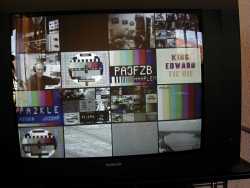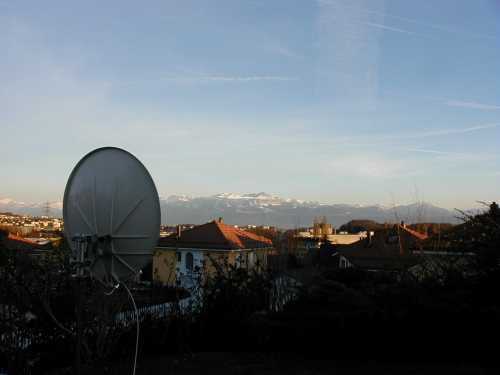|
Samedi passé, jour de grand beau temps et soleil
éclatant, j'ai voulu recevoir le satellite Eutelsat à l'aide de mon
antenne offset 10 GHz, le but étant de capter le canal du relais ATV
hollandais PI6ALK, retransmis par satellite. J'avais déjà fait un essai,
négatifs, avant Noël mais les intempéries ne m'avaient pas permis
d'aller plus loin et je n'avais pas pu voir les images de PI6ALK. Par
contre, je recevais faiblement mais B5 les canaux adjascents de ce
canal. Je commençais à avoir des doutes sur les qualités de mon antenne
10 GHz, une Visiosat de 90/110cm en
matière synthétique. Elle a été de toutes les expéditions et essais
10 GHz ces dernières années et le transport ne l'avait-il pas déformée,
d'où perte de gain?
Voilà comment j'ai contrôlé la géométrie de mon
antenne:
J'ai tout d'abord
collé un petit miroir
rectangulaire (un rond aurait mieux convenu) sur le haut de
l'antenne, dans l'axe du LNB. J'ai également collé un carton A4 sur la
face du cornet du LNB. Ensuite j'ai orienté l'antenne dans l'axe du
soleil de façon à ce que le miroir renvoie le soleil sur le LNB. Ensuite
j'ai pu contrôler que l'antenne reflétait bien le soleil sur le LNB en
promenant à la main le miroir sur tout le pourtour de l'antenne et à
l'intérieur. Le miroir étant petit, chaque position dans l'antenne
offset doit pointer sur le foyer de la parabole, donc sur le LNB. Et ce
fut bien le cas, avec une erreur d'environ 1 à 2 cm ce qui est correct
pour une parabole grand public.
Mon antenne était donc en état de marche.
 J'en
ai profité pour faire quelques mesures du bruit solaire, en m'aidant du
s-mètre du récepteur (home-made). Les valeurs étaient assez
impressionnantes mais variaient fortement en fonction de la fréquence
reçue et, malheureusement, celle où devait se trouver PI6ALK était très
mauvaise. Au s-mètre , divisé en 100 graduations, l'aiguille
marquait un maximum de 52 entre la direction du soleil et une direction
quelconque hors soleil et un minimum de 1. La différence était
considérable! J'en
ai profité pour faire quelques mesures du bruit solaire, en m'aidant du
s-mètre du récepteur (home-made). Les valeurs étaient assez
impressionnantes mais variaient fortement en fonction de la fréquence
reçue et, malheureusement, celle où devait se trouver PI6ALK était très
mauvaise. Au s-mètre , divisé en 100 graduations, l'aiguille
marquait un maximum de 52 entre la direction du soleil et une direction
quelconque hors soleil et un minimum de 1. La différence était
considérable!
J'ai alors intercalé un préampli de ligne pour LNB (commercial) suivi
d'un atténuateur variable. En réglant le tout à l'optimal, la
polarisation y compris, je suis
arrivé à recevoir PI6ALK avec un rapport signal/bruit de 8,2 dB au
maximum, lu sur l'écran du récepteur de TV. Contrairement à la TV
analogique, la TV digitale n'est pas perceptible à l'écran et le s-mètre
auditif ne sert à rien car un bouquet digital ne ressemble qu'à une
bosse de souffle sur un analyseur de spectre.
En fait, mes réglages ont augmenté l'efficacité de
ma réception de 1 à 2 dB, ce qui n'est pas négligeable
du tout.
J'ai passé l'heure suivante, avec grand plaisir, à
suivre les QSO retransmis par ce relais ATV unique en son genre!
7.3.2000
Michel E. Vonlanthen HB9AFO
How to check a
parabolic offset antenna
Past Saturday, day of big good weather and vivid
sun, I wanted to receive the Eutelsat satellite with the help of my
offset antenna 10 GHz, the goal being to capture the channel of the ATV
relay Dutch PI6ALK, broadcasted by satellite. I had already made a test,
negative, before Christmas but the inclemencies had not allowed me to go
farther and I could not have seen the pictures of PI6ALK. On the other
hand, I received weakly but B5 the channels adjascents of this channel.
I began to have some doubts on the qualities of my antenna 10 GHzes, a
Visiosat of 90/110cm in synthetic matter. She/it was of all expeditions
and tests 10 GHzes these last years and the transportation didn't he/it
have distorted it, from where loss of gain?
Here is how I controled the geometry of my antenna:
I first of all glued a small oblong mirror (a circle would have agreed
better) on the top of the antenna, in the axis of the LNB. I have
also glued an A4 cardboard on the face of the small horn of the LNB.
Then I oriented the antenna in the axis of the sun so that the
mirror sends back the sun on the LNB. Then I could control that the
antenna reflected the sun well on the LNB while walking to the hand the
mirror on the whole periphery of the antenna and inside. The mirror
being small, every position in the offset antenna must point on the home
of the parabola, therefore on the LNB. And it was well the case, with a
mistake of about 1 to 2 cm what is correct for a parabola general
public.
My antenna was therefore in working order.
I benefitted to some to make some measures of the solar noise, as using
the s measures the receptor (home-made). The values were impressive
enough but varied strongly according to the received frequency and,
unfortunately, the one where had to be PI6ALK was very bad. To the s
measures, divided in 100 graduating, the needle marked a maximum of 52
between the direction of the sun and an any direction out sun and a
minimum of 1. The difference was considerable! I inserted a préampli of
line then for LNB (commercial) follow-up of a variable atténuateur.
While adjusting the all to the optimal, the, polarization including, I
managed to receive PI6ALK with a report signal/bruit of 8,2 dB to the
maximum, read on the screen of the, receiving of TV. Contrary to the
analogical TV, the digital TV is not audible to the screen and the s
measures auditory doesn't serve to anything because a digital bouquet
only looks like a bump of breath on a sensor of specter. In fact, my
regulating increased the efficiency of my receipt of 1 to 2 dB, what is
not at all negligible. |

 J'en
ai profité pour faire quelques mesures du bruit solaire, en m'aidant du
s-mètre du récepteur (home-made). Les valeurs étaient assez
impressionnantes mais variaient fortement en fonction de la fréquence
reçue et, malheureusement, celle où devait se trouver PI6ALK était très
mauvaise. Au s-mètre , divisé en 100 graduations, l'aiguille
marquait un maximum de 52 entre la direction du soleil et une direction
quelconque hors soleil et un minimum de 1. La différence était
considérable!
J'en
ai profité pour faire quelques mesures du bruit solaire, en m'aidant du
s-mètre du récepteur (home-made). Les valeurs étaient assez
impressionnantes mais variaient fortement en fonction de la fréquence
reçue et, malheureusement, celle où devait se trouver PI6ALK était très
mauvaise. Au s-mètre , divisé en 100 graduations, l'aiguille
marquait un maximum de 52 entre la direction du soleil et une direction
quelconque hors soleil et un minimum de 1. La différence était
considérable!